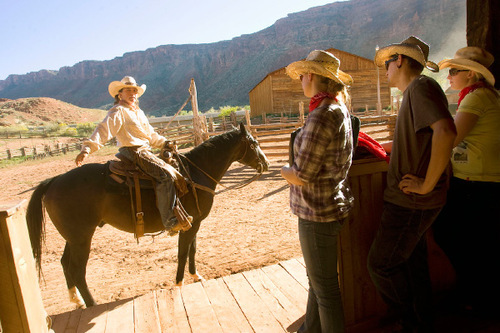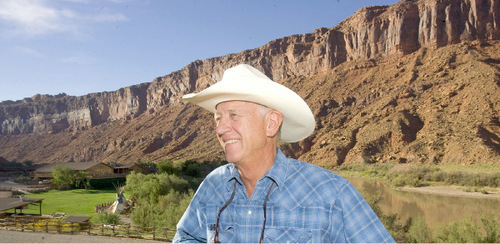This is an archived article that was published on sltrib.com in 2010, and information in the article may be outdated. It is provided only for personal research purposes and may not be reprinted.
Moab • Like most businesses, Colin Fryer's Red Cliffs Lodge struggled through 2009.
"Every call we got was people calling to cancel — group tours, individual tours, group meetings," said Fryer, whose 110-room property along the Colorado River, 14 miles north of Moab, also features a posh dining room, banquet facilities, a winery, a stable with 50 horses, a museum of Western movies shot in the vicinity and eye-popping views of Utah's redrock landscape.
But 2010 has been different, and that has been good for Grand and San Juan counties, where tourism and hospitality are the prime economic drivers of a region in need of a rebound.
"We're bucking the national trends a little bit," Fryer said. "We're still not at prerecession levels, but we're coming back. Next year looks even better. Our bookings are significantly ahead of last year."
To the south in San Juan County, economic development director Charlie DeLorme tells a similar story.
"I'm pretty darned pleased with where we stand," he said, citing transient room tax receipts that are holding steady and advance hotel room sales that are up 2 percent to 4 percent, "back near 2008 levels."
In addition, visitors are starting to spend more freely on mementoes from places such as Monument Valley. "Folks were still coming last year — visitation was off just 4 percent from 2008 — but they were buying rubber tomahawks instead of $2,000 Navajo rugs. We're encouraged to see some of those higher-end crafts starting to sell again."
A thriving tourism and hospitality industry is crucial to the quality of life in Moab, Monticello, Blanding and scattered communities called home by 25,000 people.
This is particularly true in Grand County, where roughly 1,500 people have tourism-related jobs. That number far exceeds the second-most-important employment sector — government, with roughly 900 positions — according to the Utah Department of Workforce Services.
Although government is by far the largest employer in San Juan County (more than 1,600 people in 2009) and a resurgence in uranium prices has made mining more vital, the hospitality industry and its 600-plus jobs are linchpins in stabilizing one of the state's poorer regions.
As DeLorme noted: "The extractive industries always go through a boom-bust cycle. We love the jobs when we have them. But tourism has been sustainable. It's a steady growth industry."
Steady enough that Workforce Services regional economist John Krantz noted that from 2008 to 2009, the percentage of job losses in San Juan County (2.6 percent) and Grand (3.5 percent) were better than the statewide average (5.1 percent).
That's not to say the recession did not impact the counties, whose unemployment rates always are among Utah's highest. In August, Grand was at 10.8 percent, San Juan at 12.9 (Utah's was 7.4 percent).
Almost half (48.1 percent) of all households in San Juan County, which includes part of the Navajo Indian Reservation, receive state financial assistance. In Grand County, the figure is 34.7 percent.
The decline in taxable sales in the two counties during 2009 — 15.1 percent in San Juan, 11.8 percent in Grand — also far exceeded the state average, 2.6 percent.
Still, as Moab City economic development specialist Ken Davey observed: "Although our revenues from visitation are down, they're not down as much as we feared. People are spending less once they get here. They are camping more, buying groceries at the store rather than at restaurants.
"But for the most part, businesses have weathered the downturn pretty well. There were fewer jobs this summer than last summer. But, essentially, things have stayed the same."
Tourism had help in keeping the economy afloat.
Just outside Moab, the long-awaited removal of 14 million tons of Atlas mill tailings from the shores of the Colorado River was accelerated with federal stimulus money, employing 300 people. Most were from Moab, doing basic labor, running machinery or hauling tailings to their new disposal site near Crescent Junction.
"With the stimulus money going away in 2011, we're working with the congressional delegation to keep the work level at its current pace," said Davey. "It's an important aspect of our economy, a serious employer."
Several other projects generated construction jobs — a new highway bridge over the Colorado River leading into Moab, a new hospital, additions to the high school and a grade school, a swimming pool. Two high-budget movies — one by Disney and the other about the solo climber who had to cut off his arm after it got lodged between rocks a few years back — also brought hundreds of people to the area and resulted in the hiring of a few locals.
But it was tourism that provided a sound foundation.
As one of the largest private-sector employers in Grand County (along with City Market), Red Cliffs Lodge is "a flagship facility for the region," Davey said.
The lodge employed more than 70 people this summer, said Fryer, who also owns three motels in Moab. "We're expecting this year to be our best," he added.
A Highland High School graduate who made his money in car stereos and waterbeds, Fryer bought the 230-acre riverfront property in 1990 after an extensive search throughout the West for just the right spot. "I recognized the opportunities, being next to two national parks, having the Colorado River running right through the ranch, the incredible beauty all around," he said. "I thought, 'This is my place.' I can build a lodge like the ones I've always loved."
He started building in 1998, opening a restaurant and 40 rooms in 2002. Castle Creek winery, operated by son Will, made its debut a year later. A few more rooms were added each year. Fryer also steadily expanded his horseback operations, managed by Moab native James Dixon, who also runs the company's ranch in Castle Valley.
"This is kind of cool and romantic, like [the movie] 'City Slickers,' " said recent guest Lynn Cadmus, of San Francisco, as she prepared to head out on a ride up a canyon where John Wayne movies were filmed.
Leading her troupe was wrangler Jill Franklin, who previously prepared costumes for Las Vegas showgirls. "I pinch myself every day I come to work," Franklin said. "Even if the hard times got harder or the good times got better, I'd still love this job."
Fryer has little turnover at his company. His pay scale is high by industry standards, including incentives for performance. "I don't even know what minimum wage is," said lodge general manager Sandy Bastian. Added bartender Elaine Pinkowski: "They treat us like we're important to the success of the organization. And we're required to wear jeans. That's sweet."
Keeping employees happy also is good business, said Fryer. "Turnover is one of the most expensive things you can have. If people are hospitable, we try to keep them."
That stability is good for the community at large.
Ensuring that existing businesses are successful enough to retain employees also is a goal in San Juan County, which has joined Emery and Carbon counties in BEAR — the Business Expansion & Retention Program. The slow but steady growth it encourages establishes solid ground for expansion, said economic development executive DeLorme. "We are really starting to see more economic development on the horizon."
The installation of broadband infrastructure throughout the state has given San Juan County emerging opportunities to attract an electronic device manufacturing plant and a call center to the area.
But tourism remains the key, and DeLorme sees good things happening there, too.
Last month's dedication of a new Four Corners Monument, replacing one dubbed the "absolute worst" on one travel website, is expected to attract more visitors, especially when a $1.2 million visitor center is completed.
United Airlines also is working with the county to attract more tourists from Asia, South Korea in particular. United donated six business-class flight tickets for tour operators to take a familiarization trek through southeastern Utah this fall.
DeLorme, as a matter of fact, is in South Korea and heading later this month to Singapore, where he and Utah Office of Tourism officials have a full round of meetings scheduled with tour operators from countries ranging from Australia to Japan.
"We're going to talk some serious business about getting people to Utah," he said.
Wages
San Juan County's average monthly wage increased 4 percent in 2009, the seventh-largest increase in Utah, to $2,511, but remained below the state average of $3,171
Average monthly wages in Grand County rose 1.3 percent in 2009, to $2,280, but that remained the eighth-lowest level in Utah.
Source: Utah Department of Workforce Services —
About this series
This is another in a series of occasional stories exploring the long-term effects of joblessness and the recession,. To read previous installments, go to sltrib.com/money. —
To get help
O For assistance, visit http://www.utahhelps.utah.gov
For job training and information, visit http://www.Jobs.Utah.gov
Expanding or opening a business in Grand County, call the Moab Economic Development office (435-259-5121); in San Juan County, visit http://www.southeastutah.org —
A tale of two counties
Grand • Job losses were not as severe as in most Utah counties, although unemployment was high to begin with. Taxable sales and construction remain down.
San Juan • Partly because it already has the state's highest unemployment rate, the county had fewer job losses last year. Taxable sales this year are up.





